
Health Sciences University of Hokkaido Lecturer
Yusuke Takahashi, Ph.D.
Eleuthero (scientific name: Acanthopanax Senticosus Harms) is a plant of the family Araliaceae (Photo1) that grows in nature. In Japan, it grows naturally only in Eastern Hokkaido, including Tokachi, Obihiro, Kitami, and Abashiri. In the world, it is distributed in regions with cool climate such as Siberia, Northern China, and the Korean Peninsula. From the ancient period, its root bark and stem bark have been used as Chinese medicine "Shigoka" which has nutritional fortification effect and mood-stabilizing effect. Various effectshave been reported to date such as anti-stress effect, enhancement of NK cell activity, and cancer cell proliferation inhibition (Table1). In Moscow Olympic, it was used to increase physical strength of the athlete team of Soviet Union which drew attention. In Japan, athletes of ski jumping used it to increase their physical strength. Among many components contained in eleuthero (Table2), primary active components are eleutheroside E, eleutheroside B, isofraxidin, eleutheroside B1, and chlorogenic acid. Eleuthero belongs to the family Araliaceae, the same family as Korean ginseng; it characteristically has a high content of eleutheroside E (syringaresinol diglucoside), a lignan compound.
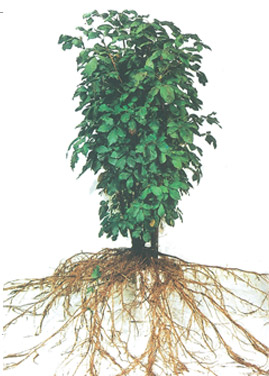
Photo1. Eleuthero
| Action | Journal |
|---|---|
| Protective effect on stress gastric ulcer | Journal of Natural Medicines 39, 1985 |
| Anti-stress effect against chronic stress | Journal of Medical Society of Toho University 37(3), 1991 |
| Prevention of decline of sexual behavior | Clinical Report 29(1), 1995 |
| Improvement effects on cognitive function in mice | Clinical Report 29(1), 1995 |
| Inhibition of lipid peroxidation | Report of Hokkaido Institute of Public Health, 1994 |
| Inhibitory effect on elevation of blood pressure after exercise | Report of Hokkaido Society of Physical Education 30, 1995 |
| Induce of β-endorphin production | Report of Hokkaido Society of Physical Education 30, 1995 |
| Induce of Growth Hormone (GH) production | Research Report, Mie University Cooperative Research Center 6, 1998 |
| Stimulation of NK-cell activity | Research Report, Mie University Cooperative Research Center 6, 1998 |
| Inhibition of stomach cancer cell proliferation | Oncology Reports 7, 2000 |
| Inhibitory effects on Amyloid β-induced neuritic atrophy and synaptic loss | Journal of Pharmacological Sciences 107, 2008 |
Table1. Action of eleuthero
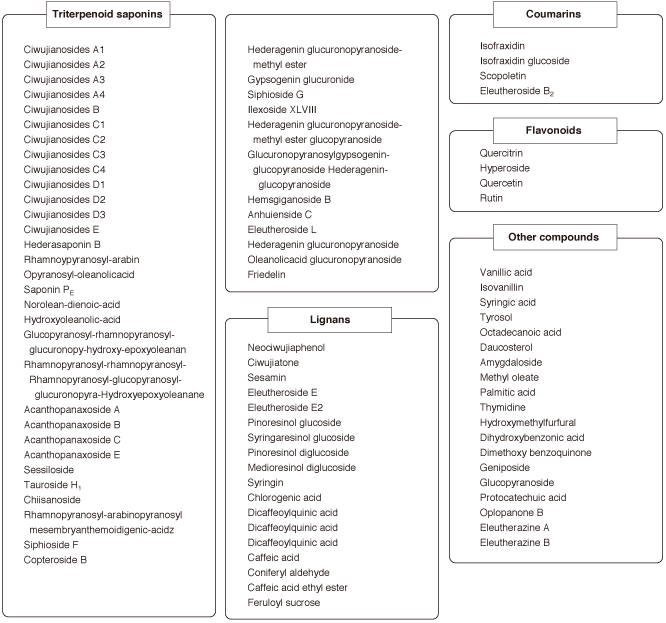
Table 2. Components in eleuthero
When we are mentally and physically stressed, it is thought that biproduct of oxygen (active oxygen) increases, causing various diseases. First, we started a research based on a hypothesis that the mechanism of anti-stress action is to remove increased active oxygen in the body. Eleuthero was added to a system where active oxygen is artificially produced in a test tube, and the amount was measured using an electronic spin resonator. The study demonstrated that eleuthero has ability to scavenge two active oxygen species, O2-(superoxide) and OH-(hydroxyl radical) that give damage to the living body (Figure1).
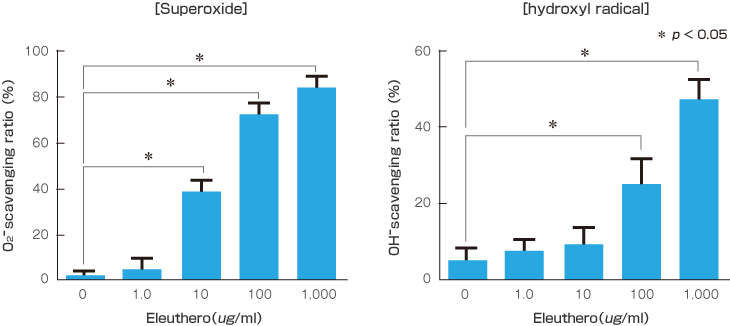
Figure1. Eleuthero's ability to scavenge active oxygen species
We studied the action of eleuthero by targeting rheumatoid arthritis (RA) among diseases in which active oxygen is involved. Chronic RA, whose cause remains to be clarified, is an autoimmune disease common in women, affecting the joints of upper and lower limbs, resulting in joint deformation. In RA, inflammation occurs in the synovium of the joints from early stage, and neutrophils, macrophages, T-cells, and B-cells infiltrate in synovial tissues. These cells produce tumor necrosis factor (TNF-α), interleukin-1 (IL-1), and interleukin-6 (IL-6), while neutrophils produce superoxide, resulting in cartilage and bone destruction and joint dysfunction. This study examined the anti-inflammatory action of eleuthero and efficacy of its combination with anti-TNF-α antibody (biological therapeutic agent of RA) using collagen-induced arthritis mouse model (hereinafter referred to as "CIA mice'') known as an RA model.
A mixed solution of 100 μg of bovine type II collagen and complete Freund's adjuvant (emulsion) was intracutaneously administered twice at an interval of three weeks to DBA/1 J male mice. Arthritis occurred in lower limbs of mice seven to 14 days after administration, causing redness and swelling (Photo2). The symptoms of arthritis were evaluated according to clinical scores as measured by calcaneal thickness and severity of swelling of the extremities, erythema, and deformation and rigidity of the joints. Eleuthero 100% extract powder was orally administered by gavage at 500 mg/kg body weight/day daily from one week before the first administration of emulsion, from the day of the second administration, or the day of the onset of arthritis. Distilled water or ascorbic acid with antioxidant capacity (vitaminC 10g/kg body weight/day) was administered to the control group in the same manner.
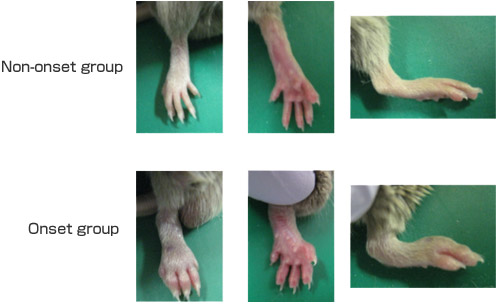
Photo2. Arthritis symptoms in mice
Delayed onset of arthritis and reduced symptoms were observed in the group of CIA mice to which eleuthero was administered from one week before emulsion administration, as compared with the group receiving distilled water (Figure2). The administration from the day of the second administration of emulsion delayed the onset but did not reduce the symptoms. The administration from the day of onset of arthritis showed no apparent effect. The results indicated that eleuthero has prophylactic effect but showed no treatment effect after the onset.
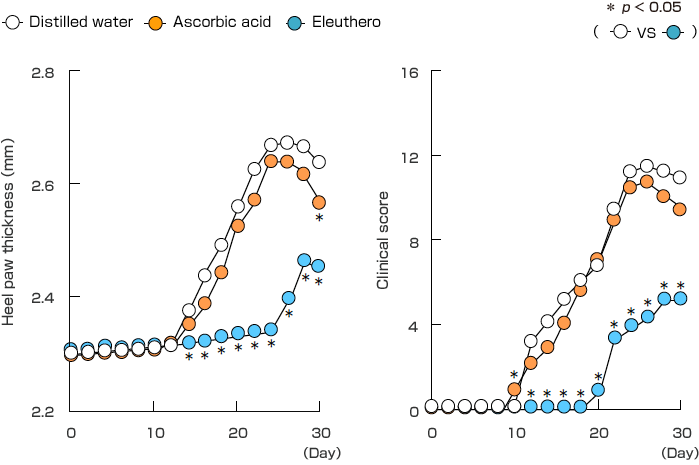
Figure2. Efficacy of eleuthero in CIA mice
At present, antirheumatic agents and biologics targeting cytokines are used as therapeutic drugs for RA; among them, anti-TNF-α antibody is primarily used. We studied whether eleuthero enhances the therapeutic effect of anti-TNF-α antibody. Eleuthero or ascorbic acid as control was orally administered by gavage daily from the day of the onset of arthritis; in addition, 50 μg of goat anti-mouse TNF-α antibody was intraperitoneally administered four times every three days. Saline or goat IgG was used as the control of goat anti-mouse TNF-α antibody.
The administration of anti-TNF-α antibody and eleuthero after the onset of arthritis achieved higher therapeutic effect as compared with anti-TNF-α antibody alone or combination with ascorbic acid (Figure3).
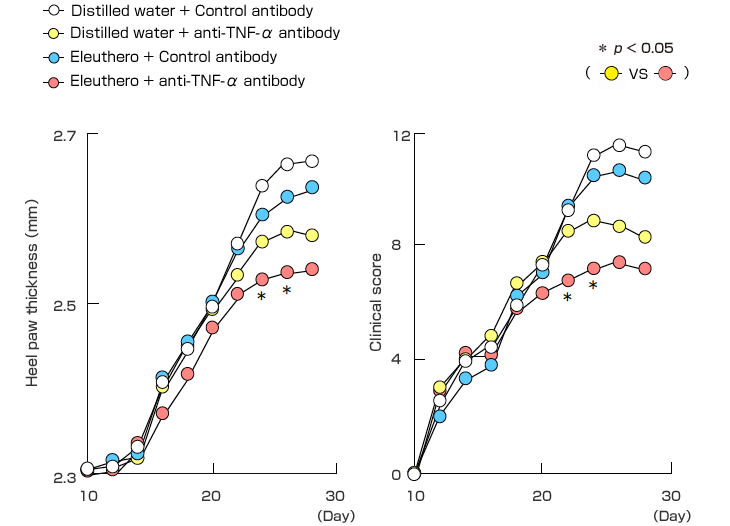
Figure3. Efficacy of combination of eleuthero with anti-TNF-αantibody in CIA mice
Human neutrophils were stimulated with a substance called phorbol myristate acetate (PMA), and the level of superoxide in the cell culture supernatant was measured by the cytochrome C method.
The level of superoxide generated by human neutrophils stimulated with PMA decreased in a concentration-dependent manner in the presence of eleuthero and vitamin C as control (Figure4).
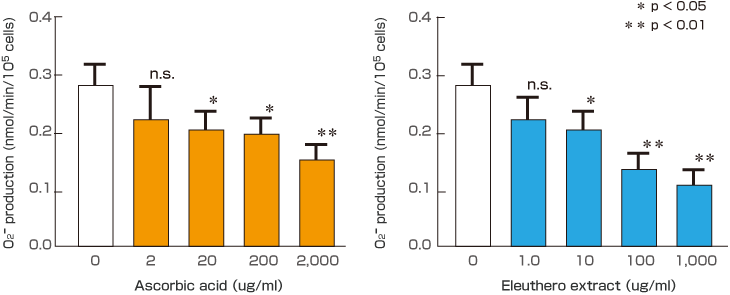
Figure4. Action of eleuthero in active oxygen
TNF-α and IL-6 have been reported to be important among inflammatory cytokines involved in RA. We studied whether eleuthero extract inhibits the production of TNF-α or IL-6. The levels of inflammatory cytokines produced were measured using human peripheral blood mononuclear cells (PBMC; monocytes, dendric cells, NK cells, T-cells, B-cells) stimulated with a substance called lipopolysaccharide (LPS); the expression levels of mRNA for TNF-α and IL-6 were determined by RT-PCR method and the expression level of protein in the cell culture supernatant by ELISA method.
In the presence of eleuthero extract, the level of mRNA in PBMC during LPS stimulation and the levels of protein in the culture supernatant for TNF-α and IL-6 markedly decreased(Figure5). Both also showed a decreasing trend for ascorbic acid, but the degree was very small as compared with eleuthero.
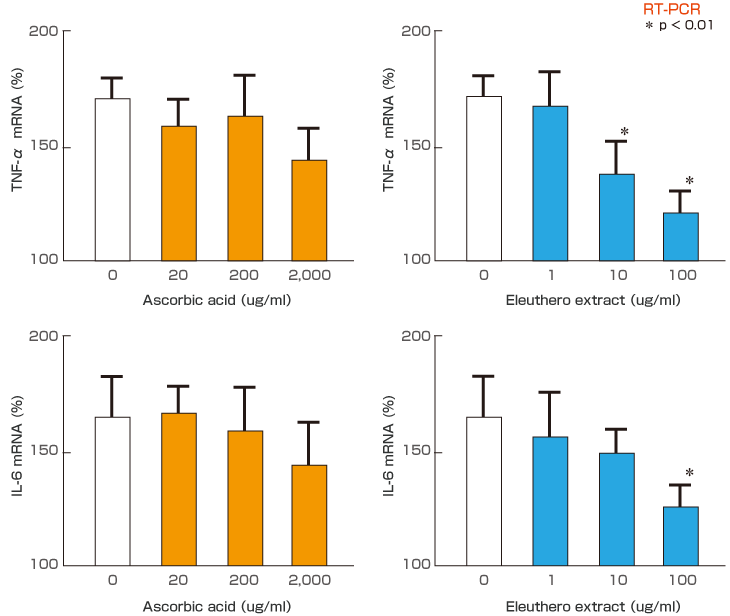
Figure5. anti-inflammatory action of eleuthero
This study was for my degree (Ph.D. in medicine), which was published as follows:
Prophylactic and Therapeutic Effects of Acanthopanax senticosus Harms Extract on Murine Collagen-induced Arthritis. Phytother Res.28:1513-1519.(2014).